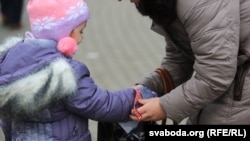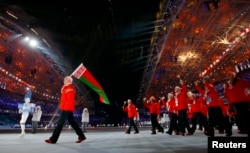MINSK -- Opposition activists in the Belarusian capital began December 6 with 5,000 meters of colorful ribbon and a plan to hand out individual segments to anyone willing to pin on their lapel or to tie around their ponytail.
Sounds harmless enough. Except the ribbons, based on a Belarusian folk embroidery pattern, are red-and-white -- colors that have become synonymous with the country's long-simmering opposition to President Alyaksandr Lukashenka and his dictatorial 20-year rule.
The campaign -- hashtagged #беларускаястужка, or "Belarusian ribbon" -- enjoyed an enthusiastic online reception, with dozens of Belarusians posting photographs and selfies with the ribbon appearing in the form of headbands, bracelets, zipper ornaments, and even a tidy bow tied onto a bird feeder.
One tweet showed the vast shipment of red-and-white ribbons still on the spool, exclaiming: "That's ribbon! All that is ribbon!"
The protest, organized by ART-Estate, a nonprofit group promoting Belarusian culture, comes as ribbons have taken on enormous political significance in neighboring Ukraine.
Kyiv supporters now regularly don the yellow-and-blue of the national flag, and their pro-Kremlin opponents wearing the orange-and-black St. George's ribbon symbolizing Russian military valor.
Lukashenka, who maintains a delicate balancing act between Russia and the West, has shown an aversion to all political symbolism emanating from the Ukraine war.
During Belarus's Victory Day celebrations in May, he surprised many by banning public display of the St. George colors.
And in November, Minsk police forced concert-goers listening to a popular Ukrainian rock band to hand over yellow-and-blue flags and blocked others dressed in Ukrainian colors from even entering.
But Lukashenka's distaste for other countries' colors pale next to his aversion to the Belarusian opposition's red-and-white, which has been banned from public display for years.
The red-and-white combination harkens back to the flag once used by the Belarusian People's Republic, the short-lived independent Belarusian state that lasted from just 1918-19.
The republic's flag, two horizontal white stripes sandwiching a single stripe of red, has since been embraced by the political opposition in post-Soviet Belarus, which is angered by the marginalization of Belarusian language and culture by Lukashenka, who speaks Russian.
The International Ice Hockey Federation has repeatedly banned displays of the white-red-white flag at world championship events, saying it represents a political symbol. Only Belarus's official flag -- a red-and-green bicolor with red-and-white embroidery on the hoist -- is allowed to be shown at sporting events outside the country.
Members of ART-Estate said the December 6 handout was timed to generated excitement ahead of the so-called Den Vyshyvanka, or Day of Embroidery, when Minsk's Palace of Arts will host master classes, shops, and games celebrating the traditional Belarusian handiwork on December 13.
Such explanations did little to reassure the Minsk police, who detained four people participating in the ribbon handout. All four were released after several hours, after the police had searched their belongings and seized 30 ribbons.
A tweet from RFE/RL's Belarus Service, saying: "Everyone to be arrested, time to disperse."


